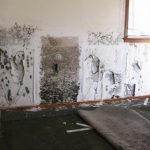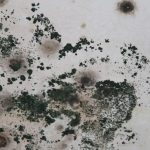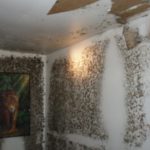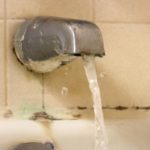Brown mold is a general term for several species of mold that commonly grow on wood, although they can also appear on surfaces like tiles and walls.
Like many other mold types, the brown mold is also a common sign of leak problems. Knowing the characteristics and removal tips can prevent the negative effects of this mold.
What Does Brown Mold Look Like?
Brown mold appears as dark patches on hard surfaces. If it spreads uncontrollably, the brown mold may look fuzzy, with small fungi growths that can appear in clusters.
There are several types of mold that look brown, such as Taeoniella, Pithomyces chartarum, Stemonitis (commonly found in the bathroom), and Aureobasidium pullulans. However, you cannot determine the exact species of the mold without actual lab analysis.
“Brown mold” is not always brown. Sometimes, you may see these mold types sporting colors such as tan, dark yellow, or even black.
Some brown mold may look black depending on the surface where it grows (for example, some mold species may look dark when growing on plywood, but brown under the microscope).
The mold also has a typical musty smell, and it releases spores that may be visible under light.
Is Brown Mold Toxic?
Brown mold that looks black may create fear over the “toxic black mold”. Even without this fear, people still think that brown mold is dangerous for health.
While mold can damage structures, and reduce the value of your property, intense fear toward this mold may be unnecessary.
Despite the typical smell and ugliness, some brown mold species are actually harmless and non-toxic. Aureobasidium pullulans is a common brown mold species, and it is not toxic.
However, mold releases spores, so you need to consider about its risks for the asthmatic or people with allergies.
Living in a prolonged period in a house infested with brown mold may invite symptoms such as sneezing, runny nose, sore throat, wheezing breath, coughing, and other typical allergic reactions or asthma symptoms.
Brown mold-infested house is also not good for babies, children, people with compromised immune system, and the elderly.
Brown Mold in Bathroom and Shower
This type of mold typically grows on plywood and other wood surfaces, but you can also find it in the bathroom. It may look like fuzzy growth or small moist blobs. The only way you can determine the species is by lab testing.
However, no matter what brown mold species that grows in the bathroom, the cause is usually similar: moisture and leakage problem.
Since brown mold is more commonly found on wood, the growth may not originate from the tile or ceramic itself. It may start from under the floorboards, between the tiles, the corners, or on the window sills.
Moist bathroom carpet or vinyl surface can also become a good growing area for brown mold.
Brown Mold on Walls
Walls are also common habitat for brown mold to grow, especially in damp or dark spaces, such as ceiling room and basement. The outer surface is not the only place brown mold can grow.
If there is plumbing problem that happens inside the wall structure, mold will grow from the inside, and slowly spread to the outer part if not removed.
Brown mold usually appears as a fuzzy layer or dark spots, depending on the level of growth. A severe infestation problem may show mold blobs and even mushrooms growing on various corners and surfaces.
Buildings that are old, or having poor lighting and leak problem, often hide mold problems behind the walls.
If you have or acquire old properties, you may want to check the presence of hidden mold. There are several methods, from manual checking to using “borescope” (checking the inside of walls through a small opening).
Brown Mold Removal Strategies
Removal strategies for brown mold are similar to other types of mold. When you find dark spots or stains that are likely to be mold, try these steps:
- Use disposable gloves and mask, plus a goggle. Make sure you do not have any asthma or allergy.
- Mix three parts of water with one part of detergent and a bottle cap of bleach. Scrub vigorously over the surface. Let it dry before repeating the scrubbing.
- If you don’t want to use detergent, use vinegar or hydrogen peroxide instead. Mix one part of this substance with three parts of water. Use the same method like the previous point for cleaning.
- Remove all materials that absorb water, such as carpet and upholstery. Put them in double bags before throwing them away as far as possible from the house.
- Make sure the cleaned area is dry and well-lit.
If you suspect a large-scale infestation, you better call mold remediation service. They know what to do with a serious brown mold problem. You may need to stay away from the house during the cleaning.
Check with your home insurance provider if you can get coverage for mold cleaning, or at least money to stay in another place while your house is still under cleaning.
How to keep the mold from coming back ?
If your house is already cleaned, make sure to keep the mold from coming back. Here is what to do:
- Create good air circulation. Fix extra ventilations in areas that may get a little fresh air or too much moisture, such as in the bathroom and kitchen.
- Make sure the interior gets a lot of sunlight. You must calculate the placement of windows to ensure equal light distribution in the house.
- Check all parts of the house for leak or plumbing problem. You may need to call an expert to check the house thoroughly if you suspect a large-scale problem.
- Do not install carpet in the bathroom or shower (or other materials that can absorb water). It can become a good place for brown mold to grow.
- Install dehumidifier if you think that the humidity level in the house is too high. It can be a good way to reduce the risk of mold growth.
Brown mold can damage and reduce the value of your property. Make sure to recognize the signs to clean it properly, and keep your house in ideal condition to prevent brown mold from coming back.






